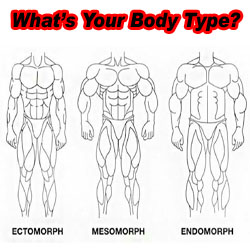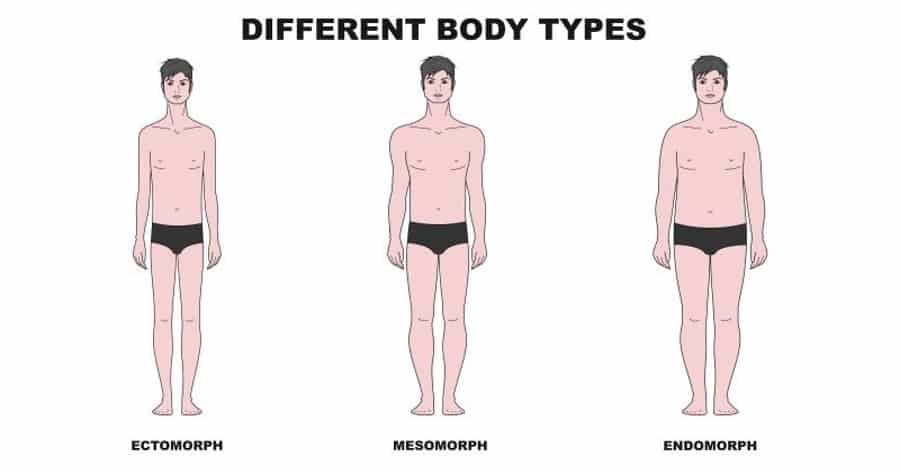

What Is the Mesomorph Diet?įirst of all, there’s not some official “mesomorph diet” that all mesomorphs eat.
#MESOMORPH BODY TYPE TRIAL#
25-30% or more of calories from protein to reduce body fat and control appetiteīut remember: at best, your somatotype is a starting point for understanding what works for your body.Įveryone is different, and the best way to learn what works is through experimentation, documenting your results, and trial and error.Low-carb or ketogenic diets to shed fat or avoid fat gain.Managing calories carefully to prevent unwanted weight gain.Whereas endomorphs, endo-mesomorphs, and ecto-endomorphs should consider: Plenty of protein to support muscle-building efforts, especially on lifting days.Higher carb intake (40-60% of calories from carbs) since they are usually resistant to fat gain.Plenty of calories to match their faster metabolism, especially for weight gain purposes.Somatotypes and Dietīefore we take a deep dive into the mesomorph diet, here’s what you need to know about the other somatotypes and their optimal dietary patterns.īecause each somatotype has particular tendencies, some eating styles suit certain somatotypes better than others.Įctomorphs and ecto-mesomorphs can benefit from:

For example, you could be a muscular, marathon-running mesomorph, or an explosive, strong ectomorph. Or you might be relatively thin with broad shoulders (an ecto-mesomorph).Īlternatively, a person who has low muscle mass, average or below-average body weight, and a pear shape would be an ecto-endomorph.Īnd regardless of your appearance, your fitness levels and training history also influence your physical traits.

Some people possess a blend of physical, metabolic, and fitness traits that don’t fit into just one box.įor example, you might be muscular with extra body-fat (an endo-mesomorph). The major somatotypes don’t describe everyone perfectly. The secondary traits of endomorphs can include trouble with unwanted fat gain, difficulty shedding fat, and average or below-average fitness levels. Secondary traits typically found in ectomorphs are low levels of strength, difficulty adding muscle, an easy time avoiding fat gain, and above-average aerobic fitness abilities.Įndomorphs, the third somatotype, are pear-shaped, soft, possess relatively high levels of body-fat, and may be shorter than average. Secondary traits of mesomorphs may include high levels of strength and power, an easy time gaining muscle mass, and relatively little difficulty with staying lean.Įctomorphs are thin and lean, typically lack broad shoulders, and are often tall. Mesomorphs are muscular, with broad shoulders, relatively narrow waists, and hard, lean physiques. However, each somatotype also has certain associated traits that relate to qualities like metabolism and fitness. Your somatotype mostly describes your appearance. Keep reading to learn the 3 primary somatotypes, as well as which one best describes your body! Are You a Mesomorph, Ectomorph, or Endomorph?

Therefore, while you might tend towards a particular somatotype, factors like gaining or losing weight, falling ill, aging, or purposely transforming your physique can change your classification. Somatotypes fall under the broader scientific concept of phenotype, which means “the observable physical characteristics of an organism.”īecause somatotypes are based on observation, they aren’t set in stone, nor are they entirely genetic. The word somatotype, coined by William Sheldon, literally means “physical type.” He called his system “constitutional psychology,” and he used it not only to describe the appearance of different physiques, but also temperament and other personality traits.īack then, constitutional psychology achieved widespread popularity, and some researchers even believed it could predict a person’s intelligence, morality, and life success.Īlthough today’s psychologists and sociologists reject constitutional psychology, exercise science researchers still use Sheldon’s physical classifications, called somatotypes, as a convenient method to describe physical appearance. In the 1940s, an American psychologist named William Herbert Sheldon invented a new theory for classifying people based on their body type.


 0 kommentar(er)
0 kommentar(er)
